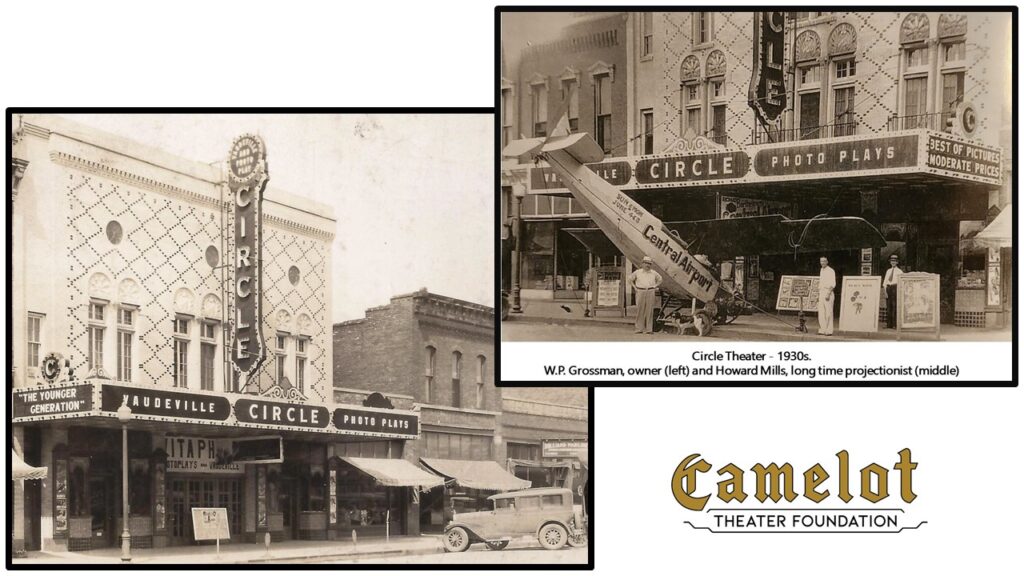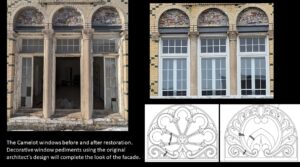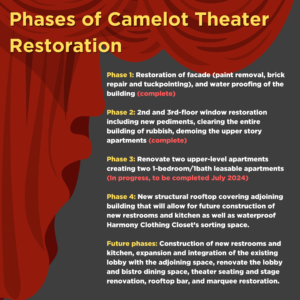If you’ve recently looked at the front of the City of Nevada, IA’s Camelot Theater, you’ve hopefully noticed the new but historically replicated white pediments above each of the second-story windows.
The pediments are the final improvement in Phase 2 of the overall theater revitalization and expansion project. This phase has also included window restoration, clearing the entire building of rubbish, and demo of the upper-story apartments. (See the graphic with a full list of all phases at the end of this story.)
“These pediments were custom-made by White River Hardwoods based in Fayetteville, Ark.,” said Camelot Theater Foundation Board member Melissa Sly. She said the Foundation was able to acquire a copy of the original hand-drawn Wetherell and Harrison architectural drawings that included the original window pediment design.
“Historical photos of the Circle Theater show this original design was used,” Sly said. “We don’t know what happened to the original pediments or in what timeframe they were changed, but the pediments we removed from the building were a more simple sunburst design made out of plywood, and they were in bad shape.”
Nick Bell, senior design professional at White River Hardwoods, said the company started this project by utilizing what he called “inspiration images” and drawings provided by the Foundation. “In this case, the drawings were luckily pretty detailed, helping us get on the same page rather quickly.”
Bell said in many projects, the company must go back and forth a lot to understand a client’s needs, but that wasn’t the case here.
“From the inspiration drawings, we built detailed CAD drawings. These were used both for client approval and for actual construction,” he said. He then described the process.
“The pieces are carved using a mix of CNC (computer numerical control) work and hand carving. We do this combination for almost all of our carved pieces. The CNC provides efficiency, and the hand carving gives the detail.”
Bell said the biggest difference between the Nevada theater pediment work and most projects that White River takes on was that the pediments were going to be placed on the exterior of a building. “Most of our work is for interior applications. (The outdoor pieces) required us to select the appropriate wood and use exterior-grade glues.”
He continued, “We also had to be mindful of the openings in the brick that these carvings were to slide into. We actually provided a full-scale template that (the Foundation’s contractors in Nevada) could use on-site to prep … while the carvings were being made.”
Sly said Set in Stone Masonry Services has been doing the brickwork for the Foundation and was also responsible for installing the new pediments.
The pediments arrived as unfinished wood, which Sly said was beautiful in that state, but the Board wanted the pieces painted white to match historic photos. Jeff Spencer, a fellow Foundation Board member and volunteer building project manager, painted them.
White River chose sapele for the pediments, a wood native to Africa similar in look and properties to mahogany. “It is a high-quality hardwood that is resistant to both rot and insects. This gives it the durability to go into an exterior application,” Bell said.
A grant from the State Historical Society of Iowa’s Historical Resource Development Program made the work of creating the historic pediments and installing them on the building possible.
Sly noted that a major grant from the Story County Community Foundation and major donations from Van Wall Equipment of Nevada were also helpful in the overall window restoration efforts of Phase 2.
Bell said he hopes the carvings will feel like they were always part of the theater. “One image we got was from the 1930s, showing the pediments that inspired our work. We want people to look at the elevation today and think our pediments are those pediments (from the 1930s) and that they were always part of this building. The best kind of historical work appears as if no work was ever done,” he said.
Sly wants to thank the many individuals, businesses, and organizations that have shown their support through donations and volunteer efforts during phases I and II of the theater restoration. “We continue to fundraise for future phases, and contributions are essential in ensuring the success of this important project,” she said. “We can’t thank the community enough for their past and ongoing support!”
–Written by Marlys Barker, City of Nevada







